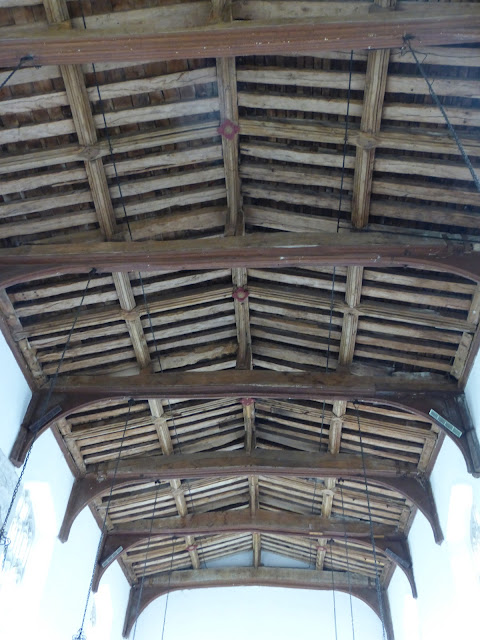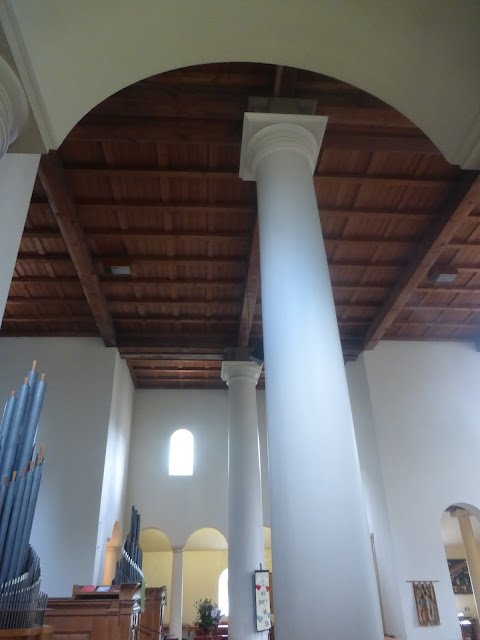
The most delightful object in Cottered church is a mural of St Christopher. Almost every church (in England at least) once had one, prominently positioned opposite the main door (usually the south) so it would be the first thing you saw as you entered, and could be glimpsed from outside. This was because it was believed that to see an image of this saint protected you from dying without the proper rites of the Church on that day. There are still getting on for two hundred medieval paintings of Christopher, far more than of any other saint, in the country, though they're in various states of preservation. (There's another good one in Newnham.)
The saint's legend tells that he was an unusually tall Canaanite, and a recent convert to Christianity, who decided to be of service by helping travellers cross a river. One day he carried a child on his shoulders across the deep and fast-flowing river, who seemed to become so heavy that he feared for their lives. When he finally reached the other side he said to the child that it felt as if he had been carrying the weight of the whole world. The child replied 'You had on your shoulders not only the whole world but Him who made it. I am Christ your king, whom you are serving by this work,' and vanished. This is just the sort of fairy-tale-like, uplifting, feelgood story beloved by medieval Christians. It's not hard to see how he became the patron saint of travellers.

In Cottered's example, which dates from the 15th century and was rediscovered under layers of whitewash in 1886, the figures of Christopher (which means 'Christ bearer') and Christ are faded to bare outlines, but fortunately the background is quite well preserved (though I think it has deteriorated and lost some of its finer detail since I first saw it in the 90s). It depicts a bird's-eye view of a schematised countryside with zigzagging roads, trees, hedgerows or fences delineating fields and the edge of roads or paths, numerous buildings (mostly large high status ones, because ordinary dwellings were presumably thought less worthy of inclusion) and occasional inhabitants. It amounts to an idealised version of a typical north east Hertfordshire landscape. A detailed description, starting top left and working down, and then the same for the right, follows.


On the left is a five-petalled flower motif with an undulating vine which runs (or once ran) all the way down the sides. At the top are several substantial-looking gabled two-storeyed half-timbered buildings, and on the right what looks like a large stone gatehouse with two towers, as if for a castle or monastery (but it abuts another half-timbered structure). To the right of this is what appears to be a church (it has what might be a cross above the gable) with an oversized bell. Between the church and gatehouse is a tree-lined road* with a tiny indistinct figure walking along it.


By far the largest figure in the background to the mural is a hermit standing in front of his hermitage; he is dressed like a parish priest, and holds in his left hand a lantern, with which to guide travellers, which is as big as his torso. (Medieval artists had little conception of strict perspective, and would probably have had little time for it even if they had; pictures were primarily didactic rather than merely representational, and figures tend to be proportioned according to their importance rather than their proximity to the picture plane.) On his right hand there's bird-like shape; could it be a hawk? This seems doubtful as surely hermits who indulged in the sport of falconry would have been frowned on. Still, it's hard to see what else it could be. To his left, and just below him, is a little wayside cross, one of several to be found.

At the bottom, from left to right, we see a castle with three towers (the central one could be a keep), a tree, and a rather elegantly posed man (much bigger than the stick figures, but smaller than the hermit) who holds a curved stick and seems to be fishing in a roughly triangular pond. An old undated (1970s?) leaflet guide to the church has a sketch of the mural and shows two dogs to his left, and a man on a horse on the castle's driveway, but they've since disappeared.


On the right of Christopher, at the top we see a ribbon-like scroll which perhaps originally had an inscription on it. Below this is a church tower and spire; to the right are three or perhaps four stick figures in the road. There was allegedly once a dog too, and together they've been interpreted (perhaps fancifully) as a hunting party. Beneath the tower are a double-gabled half-timbered building next to a single-gabled one; the latter doesn't seem to have windows but does have an unusually large door, and so may be a barn. Continuing down, the next object of interest is a windmill (only two sails remain). (The leaflet mentioned above shows another windmill at the top on the left, but again this is no longer visible.)
Next we come to two towers, possibly another castle, and below this another church tower and spire, this time with a prominent weathercock perched atop.
Still further down there's a very substantial half-timbered building - a manor house, perhaps - with a large entrance doorway and what could be a walled garden. Within this garden is found my favourite detail: two stick figures with swords. Depending on exactly when this mural was painted, a civil war (the Wars of the Roses) could have been tearing the country apart at the time, and so it's possible that the artist was reflecting this turmoil. However, as the fight involves just two combatants, and is taking place within the confines of a luxurious estate, I think it's much more likely that the figures are children playing with wooden swords.
Finally, we have an indistinct two-towered structure (possibly another church), and at the bottom another tower with a faint suggestion of other buildings.
The St Christopher mural is the church's highlight, but there's more to see. The church itself dates mostly from the mid 14th century; its prime features are a broad aiseless nave and unbuttressed tower with a taller than usual spirelet. (It raises the question: how small does a spire have to be before it's a spirelet, and how small does a spirelet have to be before it's a spike?) However, in the 15th century the church underwent a fairly major rebuilding. As well as the painting of the mural, large Perpendicular windows were knocked through in the nave, and the roofs were renewed.
A couple of nave windows have fragments of the original 15th century glazing scheme; the rest would have been smashed by iconoclasts in the 1540s/50s or a century later.
The splendid coat of arms are of Queen Anne, and date from 1712. They cost £5 1s 6d (about £800 today).
The gadrooned font was bought from Derby in 1739; it cost £20 7s 8 1/2d (about £3,500 today). There would have been an older font, but no one seems to know why it was thought necessary to replace it. It's possible that it had been removed or destroyed by zealous Puritans; there was a law passed in 1645 which abolished fonts (in favour of simple basins), which thankfully was very rarely enforced and wasn't on the statute books for long. There aren't many Georgian fonts in the county, but another slightly similar one is in Tewin.
A rustic rococo monument to Martha Forester, d.1755. I think the motifs at the top represent sunbeams piercing clouds.
Margaret Forester, d.1757. The inscription is on the pages of an open fictive book.
The 20th century contributed to the church too. The west window (partially obscured by bell ropes) was installed in 2001 (so it creeps into the 21st century) but is dated 2000 as it was commissioned to celebrate the Millennium and two thousand years of Christianity. It's by Ian Carthy of Epping Forest Stained Glass, and is quite pleasing. I like Wesley's cheery wave. To 'read' the window chronologically start at the top on the left and go down to the bottom, then work your way up the scenes on the right.
The west door has two terrific label stops from the 1980s. The benevolent bearded bespectacled bloke is the then rector, while the modern grotesque of a chap sticking his tongue out is Bruno Hooker, the then church architect. (He was also responsible for the reordering of the west end of Sandridge church.)
It might seem anticlimactic, and even bathetic, to end with a kitchen and toilet, but that's what I'm going to do. Partly because they're the most recent notable additions to the church, but also because if churches are going to continue to be used into the 21st century, and if we want them to continue to exist they will need to be used, they must be equipped to meet modern needs. (Of course, the meeting of these needs must be done with sensitivity towards the historical contexts with which they co-exist.)
When the doors are closed they look like cupboards; I casually opened one expecting to find piles of hymn books or cassocks, only to find a compact but fully functional kitchen. Congregations, audiences, visitors of all kinds can have their needs met. The fashionably pale wood blends beautifully with the stone work. When the facilities are not needed, close the doors and you hardly notice they're there. Isn't that neat?
Cottered church has always been open whenever I've visited.
 |
| Looking west |
 |
| South door |






















































































